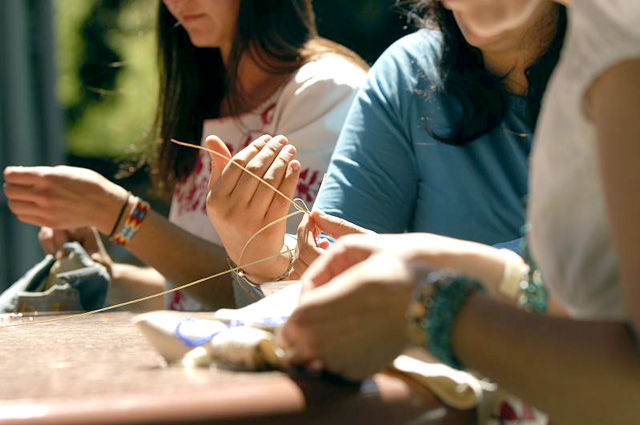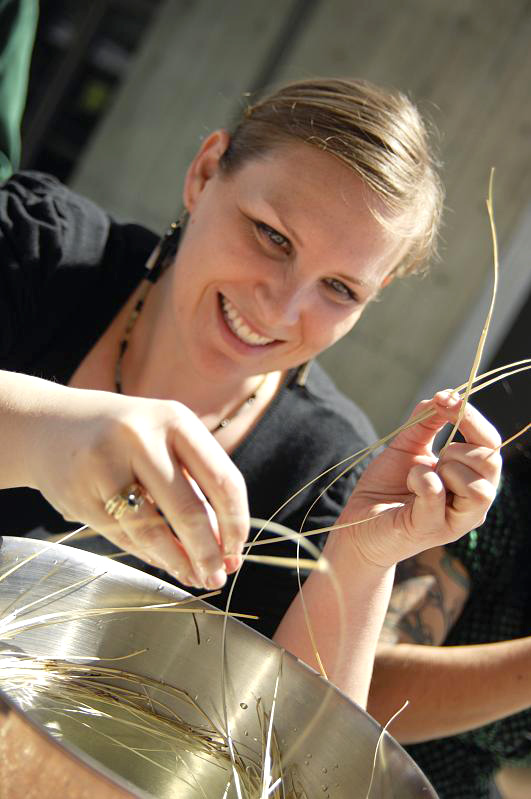
“My biggest learning experience at this University has been through the club, through the relationships and through the community we’ve created.”
Created in 1969 to bolster Native American teachers in Northern California, ITEPP (which includes the student-run club) marked its 40th year with the All Native Graduation Ceremony, on Friday, May 15 at Mckinleyville’s Azalea Hall. Today ITEPP offers curricular support for students and teachers alike, with a resource center filled with 6,000 books, videos, microfilm, and periodicals on, about or by Native American peoples.
“ITEPP was started because the community was noticing that there weren’t a lot of native teachers in front of the classrooms, especially in rural areas where there ought to be,” said Phil Zastrow, the program’s current director.
“In the early days, before ITEPP, we could count maybe four college graduates in Hoopa, and now I go look in the classrooms and see ITEPP grads working throughout the elementary and high schools. The impact that ITEPP has had in the communities has been phenomenal,” said Laura Lee George, an ITEPP graduate herself who served as the program’s director in the mid ’80s and early ’90s.
George said the mission for ITEPP became not only preparing graduates to enter the field of education, but to prepare incoming students who historically had struggled to find their place in college.
“Before ITEPP, it would be good to get a third of (the Native American) incoming freshmen class graduated. ITEPP had an 85 to 90 percent graduate rate. The students coming here were first generation students, so a lot of what we did was interpret the university culture to empower the students,” said George.
Working Through Challenges
In recent years the University has faced a series of budget cuts, and those have been felt inprograms like ITEPP.
But the latest round of cuts isn’t the only financial challenge ITEPP has faced. In its early years, the program switched from federal to state funding sources and has had to adapt to keep meeting its mission of training future educators.
“When I came here, (ITEPP) was in trouble with funding sources and we only had three students. Originally ITEPP was designed for 18 to 20 students, but thanks to better funding sources and some grants were able to raise it to 25 and then to 40,” said Lois Risling, who served as program director in the ’80s.
“We’ve lost a few positions in recent years. But I say as long as the outcome works, within a really close percentage of the old outcome, then we can get by. We might feel like we’re doing more with less, but we can’t just walk away, we have to be advocates for these students,” said Zastrow.
Risling said it’s important to recall the original reasons the program was created.
“One of the things that ITEPP continues to face is the assumption that we have enough Indian teachers. But that’s not true, because, first, people retire, but the second thing is that it becomes important for people to become teachers and enter the educational world. It becomes one of the places where our people try new ideas and interact,” said Risling.
A Sense of Community
Many of the students who come to ITEPP face significant challenges before they enroll in their first classes. They are likely to live in rural areas, making traveling to Arcata difficult. Meanwhile federal regulations regarding property ownership can affect the financial aid status for Native American students. To meet these challenges, ITEPP provides work stations and office supplies, curricular resources and, maybe most importantly, a space where students can get to know each other and have a place of their own on a campus of nearly 8,000 students.

“When I got to HSU I knew about ITEPP and at first I was intimidated not being from a local tribe,” said Briannon Fraley, a senior studying Native American Studies and Museum and Curation Practices through the Art Department. “But I knew I needed to be around people who were similar to me and that’s been the biggest influence on my education. Just having this space has been a life saver.”
Fraley serves as the ITEPP club’s chair and was nominated for a 2008 Outstanding Student Award for her work with the club. She said the club is a way for ITEPP students to support each other academically, financially and socially.
For the club’s members, it becomes a way to connect with other students passionate about supporting their native heritage and often the friendships forged at ITEPP last long after graduation.
“There is no separation for me between the club and the way that I live. You have to walk the walk, it’s not just about planning for graduation it spills into all parts of our lives,” said Pimentel.
ITEPP has a unique role to play in Northern California. With few programs like it in the Western United States, its work to prepare Native American teachers affects Humboldt County and beyond. Some see it as a way for Humboldt State to meet its mission of providing outstanding academic opportunities to all its students.
“ITEPP is an important for HSU—not only for the students but also for the institution,” said Risling.